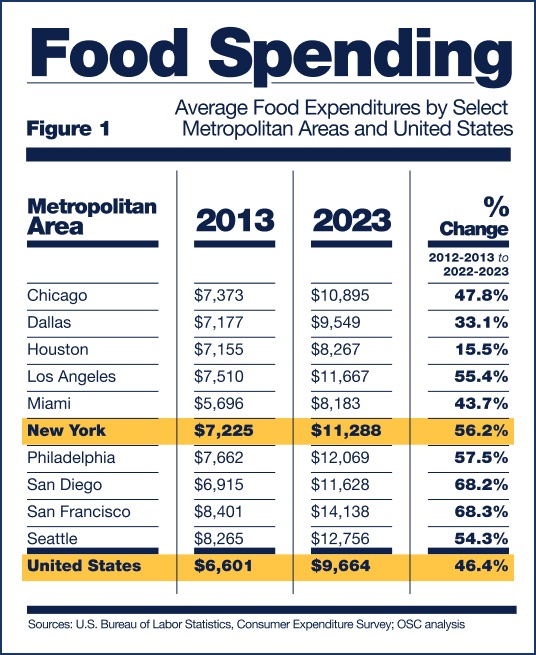Food prices in the New York City metropolitan area have risen 25.2% since 2019 and low-income households are paying substantially more toward food than before the pandemic, according to a report released today by State Comptroller Thomas P. DiNapoli.
“My office is keeping a close eye on what is driving affordability issues in the city and state, and it has not escaped anyone that higher food costs have hit household budgets in New York City hard, with price increases outpacing income growth,” DiNapoli said. “Food prices rose sharply during the pandemic, putting more New Yorkers at risk of going hungry. Now the implementation of tariffs and potential cuts to federal food and other support programs may exacerbate the problem. State and local efforts to promote access to high quality, affordable food are more important than ever to reduce food insecurity and ensure New York’s families have enough to eat.”
Nationally, food made up the third largest share (12.9%) of overall annual household spending for the average household, or about $9,664, in 2022-23, according to the latest data available from the U.S. Bureau of Labor Statistics. In the New York City metropolitan area, food costs made up the fourth largest share (12.5%) at $11,288, exceeding the national average.
Spending on Food Rises Sharply
Food costs in the New York City metropolitan area rose by 56.2% between 2012-13 and 2022-23, more than the 46.4% increase nationally. Metro area food cost growth exceeded income growth of about 52%, according to DiNapoli’s report. The food price index rose sharply during the COVID-19 pandemic partly due to higher costs of labor, supply chain disruptions, severe weather and geopolitical conflict, after years of relatively small price increases at about 2% annually.
The food price index in the New York City metropolitan area grew 8.8% from 2021 to 2022, the highest growth in over 40 years, leaving many lower-income households struggling to pay for groceries even though inflation has since cooled. Between 2023 and 2024, food price growth slowed, as the food price index in the metro area grew 1.8% compared to the nation’s 2.3% growth.
While the average household locally spent 9.2% of its income on food in 2022-23, the share varied significantly by income bracket in the Northeast region. New York City makes up about 30% of households sampled in the region. In 2022-23, households making less than $15,000 spent almost 70% of their income on food, a 16-point jump in just four years compared to a 0.7-point rise for households making $200,000 or more.
During the pandemic, food insecurity grew in New York with one in nine, or 11.3%, of households statewide (875,000 families) facing food insecurity by 2020-22.
One of the reasons for this was the ending of extraordinary federal assistance programs, including emergency food benefits. As a result, food insecurity nationally grew for the first time in over a decade to 11.2% over 2020-22. Notably, the lapse of federal assistance programs, such as expanded SNAP benefits, came at a time when the New York City metropolitan area was experiencing strong food inflation.
While food insecurity exists statewide, the majority of households experiencing food insecurity in the state live in the city (over 1.2 million residents). In 2022, the Bronx had the highest percentage of city residents experiencing food insecurity (20.2%) while Staten Island had the lowest percentage (11.5%).
Another aspect of food insecurity is food deserts, where areas including Coney Island, West and Central Harlem and the outer reaches of Queens and the Bronx, have generally lower rates of supermarkets per resident.
DiNapoli’s report found that grocery costs, also categorized as “food at home” costs, were the leading contributor to total food costs in New York City between 2012-13 and 2022 23, rising 65.8% compared to 48.8% nationally. By 2022-23, costs for groceries made up 60% of total food costs locally.
Costs for food away from home — which includes restaurants, fast food places, and vending machines — locally grew by 43.6% over that same time period.
Federally Funded Programs at Risk
Households that rely on SNAP benefits could be at risk with federal cost-cutting measures targeting essential assistance programs. If tariffs on food items are sustained, a rise in food inflation across the New York City metropolitan area and the nation is likely to occur, particularly in food away from home.
In addition, federal programs such as the Local Food Purchase Assistance Cooperative Agreement, intended to support food banks and local groups which provide food, have had funding canceled, which may in turn make it more difficult to provide food to those most in need.
With the potential for continued foreseen and unforeseen pressures on food prices, the provision of assistance for food remains critical for many families. State and local programs that help families experiencing food insecurity and encourage access to high-quality and affordable food, especially in light of potential changes to federal programs, will continue to be necessary to ensure families do not go hungry.
Report
The Cost of Living in New York City: Food
Related Reports
The Cost of Living in New York City: Transportation
The Cost of Living in New York City: Housing

